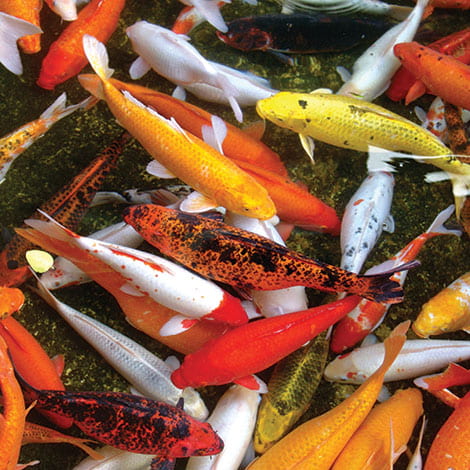Asked By: Lynn of Leitchfield, KY
A: Fish are like potato chips: It's hard to have just one. When you visit your local pet retailer or water garden center and see those goldfish and koi staring up at you through the water, how can you not take them home!
Too many fish in a pond, however, can create a poor environment for your fish and a breeding ground for algae. The more fish you have, the more waste they produce –
it's a cycle - and that waste can turn into algae fertilizer unless you have the filtration power to pump it out.
Before you start buying bucket-loads of finned friends, figure out how many you can comfortably keep in your pond. Here's how in five simple steps.
1. Calculate Pond Size
First, measure the dimensions of your pond in feet. Then use this formula to determine the capacity of your pond: Length x Width x Depth = cubic feet x 7.5 = gallons. If you need help with the math, use our
online calculator . We recommend allowing 1-2 koi or 2-3 goldfish per 200 gallons of water, so if your pond is 1000 gallons, that's approximately 5-10 koi or 10-15 goldfish."
2. Allow Room to Grow
If you're starting with young or adolescent fish, don't max out your fish volume right from the start. Remember that those little guys
will grow – a 2-inch fry will turn into a 10-inch adult in no time – and they'll produce more waste as they develop. Avoid the issues with water quality and algae growth by starting with a smaller package of adult fish such as those included in our
koi packages. You'll enjoy instant gratification and a pond full of colorful fish, and can always add more in the future!
3. Add More Slowly
Whether you're starting with young fish or adults, add just a handful at a time. Your pond will need time to "season," or build up its biological filtration system (a.k.a. beneficial bacteria), to handle the new influx of fish waste. Introduce a few fish, and then wait several weeks before adding more. While you're waiting, give your biological filter a boost with
DefensePAC Pond Care Package. It contains Nature's Defense, Clarity Defense; and Muck Defense; – all of which promote the growth of those beneficial microorganisms.
4. Keep Up with Routine Maintenance
Once your fish have moved in, help them feel right at home. Use
natural bacteria to break down fish waste, uneaten food and other debris. Provide shade, habitat and safety with floating and submerged aquatic plants. Feed them a quality diet, like The Pond Guy Staple Fish Food, which has the right amount of protein to keep them happy and well without producing a lot of excess waste. Provide a balanced ecosystem and tasty food, and you'll have a pond full of happy fish!
5. Share - or Upgrade!
If your pond is overpopulated already, you have two options: Share some of your fish with a friend (or two!), or do some upgrades in either your filtration system or your pond itself.
A external pressurized filter like the
AllClear can handle excess waste, thanks to its powerful combination of biological, mechanical and ultraviolet filters. Its backflush option makes it easy to clean, and it's easy to install in an existing pond because the plumbing doesn't need to be run through the liner.
Or if you want to upgrade your entire water feature, check out one of our
Pond Kits. Available in several different sizes, they contain a pump, pressurized filter or waterfall filter, pond liner, underlayment, plumbing, foam, hardware and beneficial bacteria to jump-start your biological filtration. All you'll need to add is fish!
Last Updated: February 2, 2023

